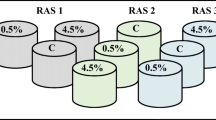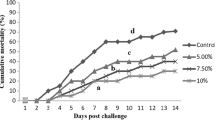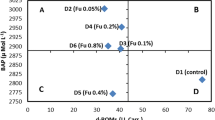Abstract
The present study investigated the effects of dietary thyme, rosemary and fenugreek supplementation on welfare status of sea bass, Dicentrarchus labrax L. assessed by blood parameters. Three experimental diets were supplemented with 1 % of the different spices. After 45 days of the feeding trial, the spices did not significantly affect the erythrocyte count, hematocrit ratio, hemoglobin level and superoxide dismutase activity (P > 0.05). However, white blood cell count, neutrophils, monocytes, phagocytic activity, lysozyme activity and myeloperoxidase activity were enhanced in spice treated groups (P < 0.05). Fish fed with the rosemary diet showed a higher respiratory burst activity as opposed to the control group (P < 0.05). Spice-supplemented diets significantly decreased serum glucose, triglyceride, cholesterol, low density lipoprotein, very low density lipoprotein, alkaline phosphatase, glutamic oxaloacetic transaminase, glutamic pyruvic transaminase, creatine kinase and lactate dehydrogenase levels (P < 0.05). On the other hand, the total protein, globulin, lipase and high density lipoprotein levels increased (P < 0.05). However, serum bilirubin, phosphorus, magnesium, chloride, calcium and iron were similar to those of the treatment groups (P > 0.05). The results of the present study indicate that dietary supplementation of 1 % thyme, rosemary or fenugreek in commercial diets could improve some hematological, immunological and biochemical status in sea bass hence they can be utilized as immunostimulants and health promoter in fish culture.

Similar content being viewed by others
References
Roncarati A, Melotti P, Dees A, Mordenti O, Angellotti L (2006) Welfare status of cultured sea bass (Dicentrarchus labrax L.) and seabream (Sparus aurata L.) assessed by blood parameters and tissue characteristics. J Appl Ichthyol 22:225–234
Caruso D, Lusiastuti AM, Slembrouck J, Komarudin O, Legendre M (2013) Traditional pharmacopeia in small scale freshwater fish farms in West Java, Indonesia: an ethnoveterinary approach. Aquaculture 416:334–345
Zilberg D, Tal A, Froyman N, Abutbul S, Dudai N, Goldhirsh AG (2010) Dried leaves of Rosmarinus officinalis as a treatment for streptococcosis in tilapia. J Fish Dis 33:361–369
Citarasu T (2010) Herbal biomedicines: a new opportunity for aquaculture industry. Aquacult Int 18:403–414
Al-Badr NA (2011) Effect of thyme powder, extract and oil on carbon tetrachloride-induced liver injury. J Am Sci 7:221–227
Al-Attar AM (2006) Comparative physiological study on the effect of rosemary, tarragon and bay leaves extract on serum lipid profile of quail, Coturnix coturnix. Saudi J biol Sci 13:91–98
Leela NK, Shafeekh KM (2008) Fenugreek. In: Parthasarathy VA, Chempakam B, Zachariah TJ (eds) Chemistry of spices, 1st edn. CAB International, Wallingford, pp 242–259
Duke JA, Godwin MJB, Cellier J, Duke PAK (2002) Handbook of medicinal herbs. CRC Press, New York
Paul BN, Sarkar S, Mukhopadhyay PK, Mohanty SN (2004) Effect of dietary attractant on feed utilisation and growth of rohu Labeo rohita (Ham.) fry. Anim Nutr Feed Techn 4:145–152
Mostafa AAZM, Ahmad MH, Mousallamy A, Samir A (2009) Effect of using dried fenugreek seeds as natural feed additives on growth performance, feed utilization, whole-body composition and entropathogenic Aeromonas hydrophila-challinge of monsex nile tilapia O. niloticus (L.) fingerlings. Aust J Basic Appl Sci 3:1234–1245
Yılmaz S, Ergün S, Soytaş N (2013a) Herbal supplements are useful for preventing streptococcal disease during first-feeding of tilapia fry, Oreochromis mossambicus. Isr Aquacult-Bamid IJA. 65:5
Yılmaz S, Ergün S, Çelik EŞ (2013b) Effect of dietary herbal supplements on some physiological conditions of sea bass Dicentrarchus labrax. J Aquat Anim Health 25:98–103
Yılmaz S (2011) Effects of dietary medicinal herbs on growth performance, feed utilization and blood parameters of sea bass (Dicentrarchus labrax L., 1758). Dissertation, University of Çanakkale Onsekiz Mart
Blaxhall PC, Daisley KW (1973) Routine hematological methods for use with fish blood. J Fish Biol 5:771–781
Siwicki AK, Anderson DP (1993) Immunostimulation in fish: measuring the effects of stimulants by serological and immunological methods. In: Siwicki AK, Anderson DP (eds) The nordic symposium on fish immunology, 1st edn. Lysekil, Sweden, pp 1–24
Liu CH, Chen JC (2004) Effect of ammonia on the immune response of white shrimp Litopenaeus vannamei and its susceptibility to Vibrio alginolyticus. Fish Shellfish Immun 16:321–334
Ellis AE (1990) Lysozyme assays. In: Stolen JS, Fletcher TC, Anderson DP, Roberson BS, Van Muiswinkel WB (eds) Techniques in fish immunology, 1st edn. SOS Publications, New Jersey, pp 101–103
Herzog V, Fahimi HD (1973) A new sensitive colorimetric assay for peroxidase using 3,3′-diaminobenzidine as hydrogen dono. Anal Biochem 55:554–562
Campbell TW (2004) Clinical chemistry of fish and amphibians. In: Thrall MA, Baker DC, Campbell TW, DeNicola D, Fettman MJ, Lassen ED, Rebar A, Weiser G (eds) Veterinary hematology and clinical chemistry, 1st edn. Lippincott Williams & Wilkins, Pennsylvania, pp 499–517
Başusta GA (2005) Fish hematology and hematological techniques. In: Karatas M (ed) Research techniques in fish biology (in Turkish), 1st edn. Nobel Publications, Ankara, pp 275–300
Morgan JD, Iwama GK (1997) Measurements of stressed states in the field. In: Iwama GK, Pickering AD, Sumpter JP, Schreck CB (eds) Fish stress and health in aquaculture. Cambridge university Press, Cambridge, pp 247–270
Heath AG (1995) Water pollution and fish physiology. CRC Lewis Publishers, London
Wiegertjes GF, Stet RJ, Parmentier HK, Van Muiswinkel WB (1996) Immunogenetics of disease resistance in fish: a comparative approach. Dev Comp Immunol 20:365–381
Brix O (2002) The physiology of living in water. In: Hart PJB, Reynolds JD (eds) Handbook of fish biology and fisheries, vol 1. Blackwell Publishing, Malden, pp 71–96
Srinivasan K (2005) Spices as influencers of body metabolism: an overview of three decades of research. Food Res Int 38:77–86
Wagner T, Congleton JL (2004) Blood chemistry correlates of nutritional condition, tissue damage, and stress in migrating juvenile chinook salmon (Oncorhynchus tshawytscha). Can J Fish Aquat Sci 61:1066–1074
Coz–Rakovac R, Perovic SI, Hacmanjek M, Popovic TN, Lipej Z, Sostaric B (2005) Blood chemistry and histological properties of wild and cultured sea bass (Dicentrarchus labrax L.) in the north adriatic sea. Vet Res Commun 29:677–687
Parpoura ACR, Alexis MN (2001) Effects of different dietary oils in sea bass (Dicentrarchus labrax L.) nutrition. Aquacult Int 9:463–476
D’Agaro E, Lanari D (2003) Effects of dietary energy content on the voluntary feed intake and blood parameters of sea bass (Dicentrarchus labrax L.). Ital J Anim Sci 2:181–189
Lemaire P, Drai P, Mathieu A, Lemaire S, Carriere S, Giudicelli J, Lafaurie M (1991) Changes with different diets in plasma enzymes (GOT, GPT, LDH, ALP) and plasma lipids (cholesterol, triglycerides) of sea bass (Dicentrarchus labrax L.). Aquaculture 93:63–75
Acknowledgments
The authors would like to thank the Çanakkale Onsekiz Mart University Research Fund for financial assistance (Project Number COMU BAP 2010/79) and Assist. Prof. Dr. Dilek Ülker ÇAKIR from University of Canakkale Onsekiz Mart, Department of Biochemistry, for help in the study. They also thank Assoc. Prof. Dr. Murat KAHVECİ for reviewing the manuscript.
Author information
Authors and Affiliations
Corresponding author
Rights and permissions
About this article
Cite this article
Yılmaz, S., Ergün, S. & Çelik, E.Ş. Effect of Dietary Spice Supplementations on Welfare Status of Sea Bass, Dicentrarchus labrax L.. Proc. Natl. Acad. Sci., India, Sect. B Biol. Sci. 86, 229–237 (2016). https://doi.org/10.1007/s40011-014-0444-2
Received:
Revised:
Accepted:
Published:
Issue Date:
DOI: https://doi.org/10.1007/s40011-014-0444-2




